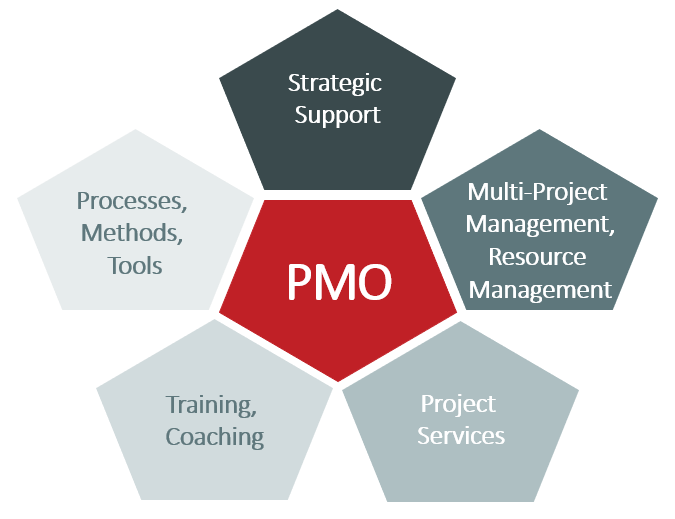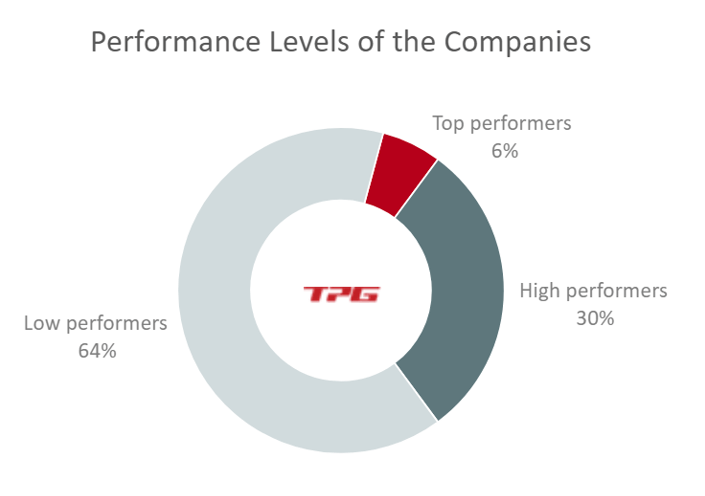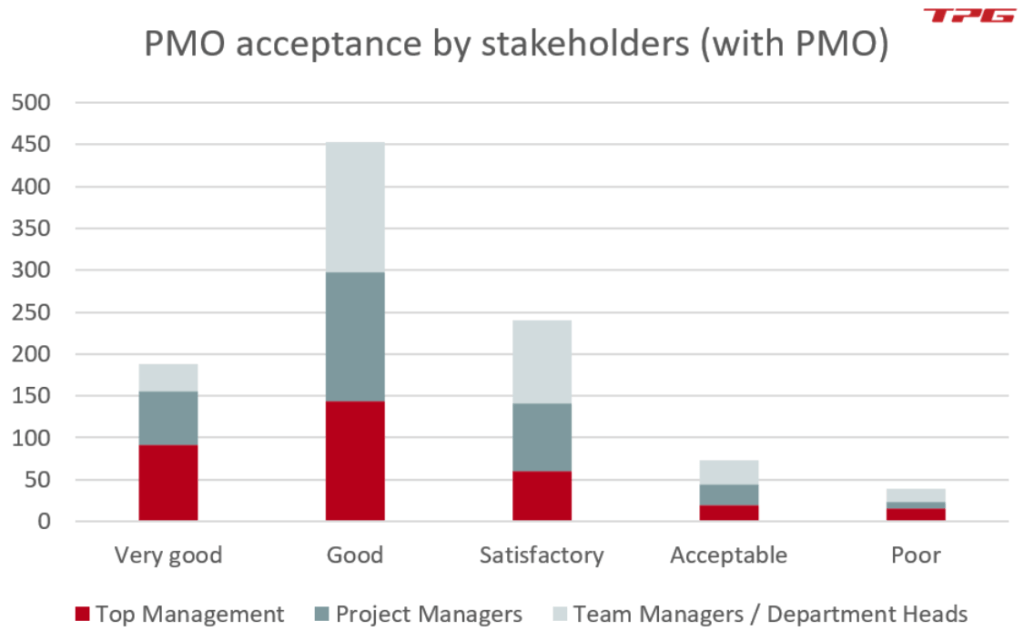What are typical pitfalls when setting up a PMO? Why is standardization not the single most important thing? And what is the role of training and communication? In 2020, TPG The Project Group conducted the PMO Survey. 330 companies with a PMO and 120 companies without a PMO took part in the survey (number of participants after data cleansing).
The objective of the survey was to show you as readers a comparison between top, high and low performers and to deduce why PMO top performers are so much better than other PMOs. The PMO Survey provides you with a benchmark when optimizing your existing PMO or setting up a new one. It is packed with practical tips and recommendations for action.
As of now, free download of the PMO Survey with 143 pages in total is possible – Part 1: Optimize Your PMO, Part 2: Establish a PMO
The PMO Survey is meant to help you assess your own position and next ventures in comparison with other companies. Another goal is to identify opportunities and priorities for improving your company’s own PMO.
In this article, we present you with the PMO Survey from 2020 in more detail. In our view, it still contains a large number of relevant statements and important practical tips:
- PMO Definition
- The TPG PMO Survey from 2020
- Benefits for companies with a PMO
- Benefits for companies wishing for a PMO
- Demographics of participants of the PMO Survey 2020
- Division into top, high and low performers
- Biggest differences in resource management
- More strategic support in the future
- Conclusion: PMO Survey
PMO Definition
The Project Management Office is a permanent organization unit that plays a key role in coordinating and managing the projects in the company or a department. Its responsibilities can include strategic support, multi-project management and resource management, project execution, training and support, methods and processes and the provision of the necessary tools.

Learn about our other, more recent survey regarding PMO Tools.
The TPG PMO Survey from 2020
Many organizations have seen a stark increase in the number of projects over the last few years. In many cases, the reason for this is digitization, which has led to many internal cross-departmental projects. Such projects often require a lot of internal coordination by employees, which is easier to implement with a PMO. However, companies often realize that they neither can nor want to afford implementing certain projects any longer. These are projects:
- Exceeding their timeframe
- Going beyond their budget or
- Failing to achieve the required goals
A PMO enables you to keep an overview of the project landscape and to increase efficiency in project management. Therefore, whether you want to set up a PMO or improve your existing PMO, use the results of this survey and learn from them.
We have divided the survey according to general information on the company in two groups.
- Information from participants who have already gained experience with a PMO (Part 1 of the Survey)
- On the other hand, we were also interested in the wishes of those companies that are only planning to establish a PMO (Part 2 of the Survey).
The survey is intended to help you as readers assess your own position, and determine what the next steps should be, by comparing your organization to other companies. Another goal is to identify opportunities and priorities for improving your company’s own PMO.
This PMO Survey provides you, or rather your PMO, with guidance in strengthening your efforts and enhancing performance in the area of project management and increasing the overall maturity level of your project environment.
Benefits for Companies with a PMO (Part 1 of the Survey)
From the answers of the companies with a PMO, we have defined performance levels for low, high and top performers. From the evaluations differentiating between these three levels, we derive explanations for the differences in their effectiveness in implementing projects. This will help readers identify what PMOs of the high and top performers do better than those of the low performers.
Benefits for Companies Wishing for a PMO (Part 2 of the Survey)
Companies that want to set up a PMO will get the following benefits from the PMO Survey: the wishes of the participants without a PMO and the responses from companies with a PMO vary immensely in parts. This makes it possible to derive realistic focus areas. Tips help you decide where best to begin when establishing a new PMO to ensure a successful launch.
Demographics of Participants of the PMO Survey 2020
450 participants from Germany, Austria and Switzerland took part in the survey, of which 330 were already operating a PMO and 120 were planning to set one up. Regarding the sector distribution, companies in the field of Information and communications are ahead of companies categorized as Other manufacturing industry and Other services.

The size of the companies with a PMO is over 1,000 employees in 60% of cases. The size of the companies without a PMO is 100-500 employees in one third of cases.
Apart from company size and industry, we also asked about:
- The PMO’s internal sphere of action
- Type of project implementation (traditional, agile, hybrid)
- Number of PMO members
- Length of the PMO’s existence
- Other classifications
Division into Top, High and Low Performers
We divided the companies having a PMO into three levels: top, high and low performers. This happened depending on their effectiveness in implementing projects based on their responses to the questions regarding compliance with deadlines, budgets and quality requirements.
Top performers
In our definition, top performers are companies with a PMO that complied with deadlines and budgets and quality requirements in more than 80% of their completed projects.
High performers
High performers, in our definition, are companies with a PMO that complied with deadlines and budgets and quality requirements in at least 50% of their completed projects but do not belong to the level of top performers.
Low performers
Companies with a PMO that complied with deadlines or budgets or quality requirements in a maximum of 50% of their completed projects.


If the PMO is to do more than define standards and deliver reports, it is invaluable to see what top performers do better than low performers.
Many companies already have a PMO, but very few have reached a sustainable level of satisfaction. Simply setting up a PMO and letting it do its thing is not enough. This is especially true if the PMO is expected to actually contribute to an increase in project management performance and thereby to an increased PM maturity level.
The comparison of the three performance levels has shown:
- Top performers and high performers are much better than low performers at providing the necessary framework for the projects.
- The top performers significantly outrank the high performers in terms of satisfaction with the PMO and are even further ahead of the low performers.
- In no part of the PMO Survey did the low performers ever excel over the high performers or the top performers.
Biggest Differences in Resource Management
There are marked differences in the performance levels with regard to multi-project management and resource management responsibilities as well as in individual areas of training and strategic support. The biggest difference is in strategic capacity planning and the management of employee skills, followed by the availability of career paths for project managers and the ability to demonstrate the projects’ strategic value.
Acceptance of the PMO
The acceptance of the stakeholders of the PMO in companies with PMO is highest among the top performers, significantly less among the high performers and least among the low performers. The difference is particularly evident in top management, with top performers having a three times higher percentage of the “very satisfied” rating compared to the low performers.
Most of the project managers and team leaders / department heads rated the acceptance as good and satisfactory. This seems to imply that there is a benefit but with significant room for improvement.

The graphic below shows the wish for a PMO felt by survey participants without an institution of this kind. The result compared to companies with a PMO: in companies without a PMO, top management does not see the benefit enough whereas in companies with a PMO top management rate the benefit highest of all stakeholders.

Apparently, the roles wishing for a PMO need to work harder to communicate the benefits of a PMO to convince top management.
Our tip: Seek the exchange of experience with the top management of other companies already enjoying the benefits of a PMO. This can provide you with arguments to convince your decision-makers to entrust PMO functions to a central institution of this kind as well.
Among the factors hindering an increased acceptance, top performers cited “No clear advantages to having a PMO” and a “Lack of transparency in resource planning” only half as often as low performers.

Special Download (PDF): What are typical PMO Functions? (+ their importance)
This article provides you with a good comparison as well as ideas for functions you could consider next for your PMO. Please fill in the form to download.
* Required Fields | Data Protection
More Strategic Support in the Future
Irrespective of the performance levels, PMOs intend to shift their efforts:
- Less standardization and managing projects
- More strategic support and training of project managers
- More support in multi-project and resource management
The key priorities for the next 12 months mentioned by at least 20% of the survey participants were:
- Implementing a knowledge database for project managers
- Strategic capacity planning
- Ensuring the strategic alignment of projects and ideas
- Sharing knowledge with finance and accounting departments
- Managing cross-project dependencies
When asked for the best way to increase PMO acceptance, the most frequent response was that the PMO should strive to add real value. To do this, stakeholders must be surveyed to determine their expectations, and then the PMO must adjust its services accordingly.
Our tip: To determine the expectations, the survey should start by surveying top management. This will enable you to formulate the PMO’s mission clearly in a way that will not make it appear as a cost center only. The best way to create transparency depends on the company’s corporate culture, which means that it requires trust and time. The PMO can hereby set the course with the backing of top management.
Conclusion: PMO Survey
The survey of companies with and without a PMO in the context of the TPG PMO Survey enables a 360-degree analysis of priorities:
- Support in setting priorities: The PMO Survey provides an excellent overview of the companies’ PMO priorities from which you will benefit greatly.
- Orientation thanks to an excellent PMO benchmark: The differentiation between top, high and low performers means you will know directly where you are at present and where you should be heading.
- Realistic assessment due to empirical values: The illustration of the expectations of PMO newcomers and the comparison with reality gives you a feeling for your own expectations.
- You learn from the top performers: You will prevent frequent mistakes and learn directly how to do it properly because we have condensed the top performers’ experience for you!
So download the survey, which is now available for free, straight away – Part 1 (improve your existing PMO) or Part 2 (establish a successful new PMO).
Our final tips
Get to know the individually adaptable “PPM Paradise” – the optimal environment for your enterprise-wide project, program, portfolio and resource management. Download the eBook now (just click, no form).
And sign up for our bi-weekly blog newsletter to make sure you receive all our updates.
What are your dos & don’ts for a successful PMO? Please share your experiences in the comments section below!
Subscribe to TPG BlogInfo: Never miss new practice-oriented tips & tricks
Every other week: Receive practical tips in TPG blog posts written by recognized experts in project, portfolio, and resource management.
* Required Fields | Data Protection
 Johann Strasser
Johann Strasser
Managing Partner at TPG
The certified engineer, has been a managing partner at TPG The Project Group since 2001. After many years as a development engineer in the automotive and energy sectors, Johann Strasser spent a decade as an independent trainer and consultant in the field of project management. During his tenure, he also served as project manager for software projects in the construction industry and provided scheduling and cost management support for large-scale construction projects. At TPG, he applies his expertise in product development and consulting services for international clients. His special focus is on PMO, project portfolios, hybrid project management, and resource management. For many years now, he has shared his knowledge through presentations, seminars, articles, and webinars.
Read more about Johann Strasser on LinkedIn and XING.
 Achim Schmidt-Sibeth
Achim Schmidt-Sibeth
Senior Marketing Manager
After earning his engineering degree in environmental technology, he gained many years of experience in project management through his work at an engineering office, an equipment manufacturer, and a multimedia agency. Achim Schmidt-Sibeth and his team have been responsible for marketing and communication at TPG The Project Group for many years now.











